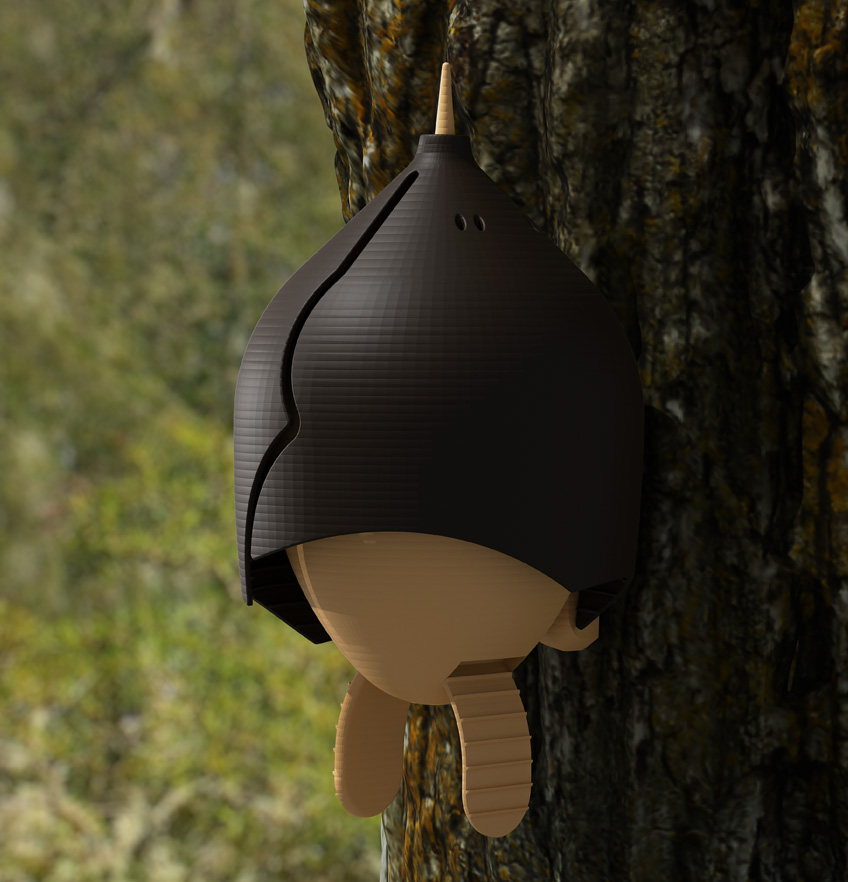A graduate at design creates a shelter for Pamplona's bats
Ariane Legarra, a graduate of design, aims to help with her project 'Bao' the medium-sized cockatoo, a species of bat that lives in the capital of Navarre.

PhotoAnaBelén Poza/Ariane Legarra and her product 'Bao', designed for her end-of-year work Degree
24 | 07 | 2024
Ariane Legarra, from Alsasua and recently graduated in design (accredited specialization in Product) from the University of Navarra, culminated her programs of study with enrollment of honor in her work of the end of Degree (TFG), Bao, an artificial shelter for medium-sized cockatoos(Nyctalus noctula), a species of bat that inhabits Pamplona. "It is a vulnerable species that, despite being distributed throughout much of Eurasia, its mentions in Spain are limited and, specifically, in Pamplona is the largest colony. Therefore, this project was created in response to the scarcity of natural refuges they face", explains Ariane.
The idea for his TFG was proposal by his tutors Enrique Baquero Martín and José Manuel Cabrero Ballarín, professors at School of Sciences and the University's School of Architecture, respectively. "They saw that it was a good opportunity to develop a product that, in addition to offering shelter alternatives to bats, would work as a singular element that would serve to impact the knowledge dissemination of the need for an animal group core topic in the control of harmful insects. I thought it was a very interesting and beautiful initiative and decided to carry it out," says the designer.
The recent graduate at design says that the most rewarding part of project has been discovering the work of bats and trying to improve their quality of life. "Developing it has helped me to realize the great interdisciplinarity of design. As our professors explain, it is a degree program that serves as a bridge, connecting people from different disciplines. It has been very interesting to work with people with points of view outside the world of design, as they have allowed me to develop a product that can actually work in reality. I am also very happy to have been able to create a project to protect an endangered species that lives so close to us," says Ariane.
A 3D printed 'home
Several of Pamplona's refuges are located at campus of the University of Navarra. Being a migratory species, the capital of Navarra becomes an essential strategic location for the survival of the mockingbird.
The recent graduate has based her design on the different programs of study that have been carried out on the species and on the different commercial nest boxes: "It was complicated for me to take into account all the necessary requirements that the shelter had to comply with in order to be effective and, at the same time, to develop a product that was aesthetically appropriate. Even so, by adjusting the design and doing different tests and consulting with my tutors, I managed to integrate them until I arrived at Bao's design ".

Rendering of Bao by designer Ariane Legarra.
During her research, Ariane discovered that medium-sized cockatoos often occupy abandoned woodpecker nests, so Bao' s design tries to mimic their shape and conditions. Therefore, in addition to simulating the shape of a bat hanging upside down, the product has two zones for different life stages of the midsize cockatoos: "The egg is a mating and hibernation area (autumn-winter) and the wings resting on top provide a space for high hunting seasons (spring-summer). The entire interior and landing area have rough surfaces so that the cockatoos can move around easily," explains the recent graduate.
The parts are manufactured using 3D printing and the inner cork plates are laser-cut. "These technologies allow manufacturing to be decentralized, so that the product can accompany and protect the bat throughout its migration path. Encouraging its installation could bring bats closer to society, counteracting prejudices and educating about their harmlessness and crucial role in the balance of the ecosystem," says Ariane.




